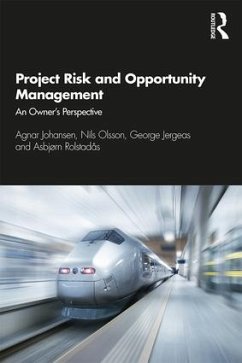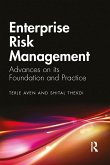Agnar Johansen (Norway SINTEF), Nils Olsson (Norwegian University of Science and Technology), George Jergeas (University of Calgary)
Project Risk and Opportunity Management
The Owner's Perspective
Agnar Johansen (Norway SINTEF), Nils Olsson (Norwegian University of Science and Technology), George Jergeas (University of Calgary)
Project Risk and Opportunity Management
The Owner's Perspective
- Broschiertes Buch
- Merkliste
- Auf die Merkliste
- Bewerten Bewerten
- Teilen
- Produkt teilen
- Produkterinnerung
- Produkterinnerung
This book is about opportunity management seen from the owner's perspective. It will be an invaluable resource for those studying Engineering both undergraduate and postgraduate and set out ways in which projects should be managed from planning to completion.
Andere Kunden interessierten sich auch für
![The E-Myth Manager The E-Myth Manager]() Michael E. GerberThe E-Myth Manager17,99 €
Michael E. GerberThe E-Myth Manager17,99 €![When The Heavens Went On Sale When The Heavens Went On Sale]() Ashlee VanceWhen The Heavens Went On Sale10,99 €
Ashlee VanceWhen The Heavens Went On Sale10,99 €![When The Heavens Went On Sale When The Heavens Went On Sale]() Ashlee VanceWhen The Heavens Went On Sale28,99 €
Ashlee VanceWhen The Heavens Went On Sale28,99 €![Enterprise Risk Management Enterprise Risk Management]() Terje AvenEnterprise Risk Management49,99 €
Terje AvenEnterprise Risk Management49,99 €![The Psychology of Creative Performance and Expertise The Psychology of Creative Performance and Expertise]() Kathryn FriedlanderThe Psychology of Creative Performance and Expertise70,99 €
Kathryn FriedlanderThe Psychology of Creative Performance and Expertise70,99 €![The Reflective Entrepreneur The Reflective Entrepreneur]() Dimo Dimov (UK University of Bath)The Reflective Entrepreneur46,99 €
Dimo Dimov (UK University of Bath)The Reflective Entrepreneur46,99 €![Overcoming Barriers to Student Understanding Overcoming Barriers to Student Understanding]() Jan Meyer (UK University of Durham)Overcoming Barriers to Student Understanding75,99 €
Jan Meyer (UK University of Durham)Overcoming Barriers to Student Understanding75,99 €-
-
-
This book is about opportunity management seen from the owner's perspective. It will be an invaluable resource for those studying Engineering both undergraduate and postgraduate and set out ways in which projects should be managed from planning to completion.
Hinweis: Dieser Artikel kann nur an eine deutsche Lieferadresse ausgeliefert werden.
Hinweis: Dieser Artikel kann nur an eine deutsche Lieferadresse ausgeliefert werden.
Produktdetails
- Produktdetails
- Verlag: Taylor & Francis Ltd
- Seitenzahl: 164
- Erscheinungstermin: 10. April 2019
- Englisch
- Abmessung: 234mm x 156mm x 9mm
- Gewicht: 250g
- ISBN-13: 9781138365827
- ISBN-10: 1138365823
- Artikelnr.: 56386535
- Herstellerkennzeichnung
- Libri GmbH
- Europaallee 1
- 36244 Bad Hersfeld
- gpsr@libri.de
- Verlag: Taylor & Francis Ltd
- Seitenzahl: 164
- Erscheinungstermin: 10. April 2019
- Englisch
- Abmessung: 234mm x 156mm x 9mm
- Gewicht: 250g
- ISBN-13: 9781138365827
- ISBN-10: 1138365823
- Artikelnr.: 56386535
- Herstellerkennzeichnung
- Libri GmbH
- Europaallee 1
- 36244 Bad Hersfeld
- gpsr@libri.de
Agnar Johansen is Senior Research Scientist at SINTEF Technology Management, Department of Industrial Management, Trondheim, Norway. Nils O. E. Olsson is Professor in Project Management at The Norwegian University of Science and Technology, Trondheim, Norway. George Jergeas is Director, Centre of Project Management Excellence, and Professor at The Schulich School of Engineering, University of Calgary, Calgary, Canada. Asbjørn Rolstadås is Professor Emeritus of Mechanical and Industrial Engineering at the Norwegian University of Science and Technology, Trondheim, Norway.
PREFACE
CONTENTS
LIST OF FIGURES
LIST OF TABLES
Part I - WHY CHASE OPPORTUNITIES?
1. PROJECT BUSINESS
1.1. The lost opportunities
1.2. Current industry practice
1.3. From project delivery to value creation
1.4. Type of projects
1.5. Major stakeholders
1.6. Unpredictability in projects
2. HOW PROJECTS ARE DELIVERED
2.1. Stage gate models in projects
2.2. Project phases
2.3. Planning a project
2.4. Implementing a project
3. THE OWNER AND HIS ROLE
3.1. Project ownership
3.2. Project sponsor, asset owner and PEO
3.3. Governance
3.4. Users
3.5. Project owners and success
3.6. Financing of projects
3.7. Project owners and uncertainty management
4. RISKS AND OPPORTUNITIES
4.1. Uncertainty versus risk and opportunity
4.2. Uncertainty categories
4.3. Risk and opportunity categories
4.4. Risk and opportunity from the perspective of time
4.5. Risk management
4.6. Project complexity
4.7. Reflections on project uncertainty in an owner perspective
5. RISK AND OPPORTUNITY MANAGEMENT APPROACH
5.1. The management process
5.2. Identifying and quantifying risks and opportunities
5.3. Tools and techniques: how to find opportunities
5.4. Opportunities as reaction and iterations for opportunity management
5.5. Benefits
Part II - HOW TO CHASE OPPORTUNITIES?
6. PRACTICAL RISK AND OPPORTUNITY MANAGEMENT
6.1. Opportunities in projects
6.2. Cost and schedule
6.3. Quality
6.4. Real options
6.5. Lean thinking
6.6. Last responsible moment integrated planning
6.7. Project flexibility can provide opportunities
6.8. Exploiting opportunities
7. CONTINGENCY CALCULATIONS
7.1. Cost contingency
7.2. Schedule contingency
7.3. Generic contingency calculation methods
7.4. Cost contingency calculations
7.5. Schedule contingency calculations
8. CONTRACTUAL PRACTICES AND COLLABORATIVE RELATIONSHIPS
8.1. Contracts and risk
8.2. Risk allocation in contracts
8.3. Contractual arrangements and types
8.3.1. Design-Bid-Build or General Contractor Concept
8.3.2. Design-Build or EPC
8.3.3. Construction Management
8.4. Contract price arrangements or payment structures
8.4.1. Fixed Price Contracts
8.4.2. Cost Reimbursable Contracts
8.4.3. Guaranteed Maximum Price Contracts
8.4.4. Convertible Contracts
8.4.5. Frequent disputes and claims
8.5. The collaborative construction model
8.5.1. What is the mission of the systems integrator?
8.5.2. What does the systems integrator do?
8.5.3. Where does the systems integrator reside?
8.5.4. Who should staff the systems integrator?
8.5.5. Critical success factors for the collaborative construction model
9. CASE STUDY - RAIL IN MEDIUM SIZE CITY
9.1. The business case for railway projects
9.2. Commercial perspective, revenues and costs
9.3. Socio-economic perspective
9.4. The case study
9.5. Uncertainty development
9.6. Chasing opportunities in the case
9.6.1. Reducing investment cost
9.6.2. Reducing operational cost
9.6.3. Reducing inconveniences
9.6.4. Increasing benefits
PART III - CHANGED MINDSET
10. CHANGED INDUSTRY MINDSET
10.1. Industry best practices
10.2. Shifts in mindset
10.3. The change process
ABBREVIATIONS
REFERENCES
INDEX
CONTENTS
LIST OF FIGURES
LIST OF TABLES
Part I - WHY CHASE OPPORTUNITIES?
1. PROJECT BUSINESS
1.1. The lost opportunities
1.2. Current industry practice
1.3. From project delivery to value creation
1.4. Type of projects
1.5. Major stakeholders
1.6. Unpredictability in projects
2. HOW PROJECTS ARE DELIVERED
2.1. Stage gate models in projects
2.2. Project phases
2.3. Planning a project
2.4. Implementing a project
3. THE OWNER AND HIS ROLE
3.1. Project ownership
3.2. Project sponsor, asset owner and PEO
3.3. Governance
3.4. Users
3.5. Project owners and success
3.6. Financing of projects
3.7. Project owners and uncertainty management
4. RISKS AND OPPORTUNITIES
4.1. Uncertainty versus risk and opportunity
4.2. Uncertainty categories
4.3. Risk and opportunity categories
4.4. Risk and opportunity from the perspective of time
4.5. Risk management
4.6. Project complexity
4.7. Reflections on project uncertainty in an owner perspective
5. RISK AND OPPORTUNITY MANAGEMENT APPROACH
5.1. The management process
5.2. Identifying and quantifying risks and opportunities
5.3. Tools and techniques: how to find opportunities
5.4. Opportunities as reaction and iterations for opportunity management
5.5. Benefits
Part II - HOW TO CHASE OPPORTUNITIES?
6. PRACTICAL RISK AND OPPORTUNITY MANAGEMENT
6.1. Opportunities in projects
6.2. Cost and schedule
6.3. Quality
6.4. Real options
6.5. Lean thinking
6.6. Last responsible moment integrated planning
6.7. Project flexibility can provide opportunities
6.8. Exploiting opportunities
7. CONTINGENCY CALCULATIONS
7.1. Cost contingency
7.2. Schedule contingency
7.3. Generic contingency calculation methods
7.4. Cost contingency calculations
7.5. Schedule contingency calculations
8. CONTRACTUAL PRACTICES AND COLLABORATIVE RELATIONSHIPS
8.1. Contracts and risk
8.2. Risk allocation in contracts
8.3. Contractual arrangements and types
8.3.1. Design-Bid-Build or General Contractor Concept
8.3.2. Design-Build or EPC
8.3.3. Construction Management
8.4. Contract price arrangements or payment structures
8.4.1. Fixed Price Contracts
8.4.2. Cost Reimbursable Contracts
8.4.3. Guaranteed Maximum Price Contracts
8.4.4. Convertible Contracts
8.4.5. Frequent disputes and claims
8.5. The collaborative construction model
8.5.1. What is the mission of the systems integrator?
8.5.2. What does the systems integrator do?
8.5.3. Where does the systems integrator reside?
8.5.4. Who should staff the systems integrator?
8.5.5. Critical success factors for the collaborative construction model
9. CASE STUDY - RAIL IN MEDIUM SIZE CITY
9.1. The business case for railway projects
9.2. Commercial perspective, revenues and costs
9.3. Socio-economic perspective
9.4. The case study
9.5. Uncertainty development
9.6. Chasing opportunities in the case
9.6.1. Reducing investment cost
9.6.2. Reducing operational cost
9.6.3. Reducing inconveniences
9.6.4. Increasing benefits
PART III - CHANGED MINDSET
10. CHANGED INDUSTRY MINDSET
10.1. Industry best practices
10.2. Shifts in mindset
10.3. The change process
ABBREVIATIONS
REFERENCES
INDEX
PREFACE
CONTENTS
LIST OF FIGURES
LIST OF TABLES
Part I - WHY CHASE OPPORTUNITIES?
1. PROJECT BUSINESS
1.1. The lost opportunities
1.2. Current industry practice
1.3. From project delivery to value creation
1.4. Type of projects
1.5. Major stakeholders
1.6. Unpredictability in projects
2. HOW PROJECTS ARE DELIVERED
2.1. Stage gate models in projects
2.2. Project phases
2.3. Planning a project
2.4. Implementing a project
3. THE OWNER AND HIS ROLE
3.1. Project ownership
3.2. Project sponsor, asset owner and PEO
3.3. Governance
3.4. Users
3.5. Project owners and success
3.6. Financing of projects
3.7. Project owners and uncertainty management
4. RISKS AND OPPORTUNITIES
4.1. Uncertainty versus risk and opportunity
4.2. Uncertainty categories
4.3. Risk and opportunity categories
4.4. Risk and opportunity from the perspective of time
4.5. Risk management
4.6. Project complexity
4.7. Reflections on project uncertainty in an owner perspective
5. RISK AND OPPORTUNITY MANAGEMENT APPROACH
5.1. The management process
5.2. Identifying and quantifying risks and opportunities
5.3. Tools and techniques: how to find opportunities
5.4. Opportunities as reaction and iterations for opportunity management
5.5. Benefits
Part II - HOW TO CHASE OPPORTUNITIES?
6. PRACTICAL RISK AND OPPORTUNITY MANAGEMENT
6.1. Opportunities in projects
6.2. Cost and schedule
6.3. Quality
6.4. Real options
6.5. Lean thinking
6.6. Last responsible moment integrated planning
6.7. Project flexibility can provide opportunities
6.8. Exploiting opportunities
7. CONTINGENCY CALCULATIONS
7.1. Cost contingency
7.2. Schedule contingency
7.3. Generic contingency calculation methods
7.4. Cost contingency calculations
7.5. Schedule contingency calculations
8. CONTRACTUAL PRACTICES AND COLLABORATIVE RELATIONSHIPS
8.1. Contracts and risk
8.2. Risk allocation in contracts
8.3. Contractual arrangements and types
8.3.1. Design-Bid-Build or General Contractor Concept
8.3.2. Design-Build or EPC
8.3.3. Construction Management
8.4. Contract price arrangements or payment structures
8.4.1. Fixed Price Contracts
8.4.2. Cost Reimbursable Contracts
8.4.3. Guaranteed Maximum Price Contracts
8.4.4. Convertible Contracts
8.4.5. Frequent disputes and claims
8.5. The collaborative construction model
8.5.1. What is the mission of the systems integrator?
8.5.2. What does the systems integrator do?
8.5.3. Where does the systems integrator reside?
8.5.4. Who should staff the systems integrator?
8.5.5. Critical success factors for the collaborative construction model
9. CASE STUDY - RAIL IN MEDIUM SIZE CITY
9.1. The business case for railway projects
9.2. Commercial perspective, revenues and costs
9.3. Socio-economic perspective
9.4. The case study
9.5. Uncertainty development
9.6. Chasing opportunities in the case
9.6.1. Reducing investment cost
9.6.2. Reducing operational cost
9.6.3. Reducing inconveniences
9.6.4. Increasing benefits
PART III - CHANGED MINDSET
10. CHANGED INDUSTRY MINDSET
10.1. Industry best practices
10.2. Shifts in mindset
10.3. The change process
ABBREVIATIONS
REFERENCES
INDEX
CONTENTS
LIST OF FIGURES
LIST OF TABLES
Part I - WHY CHASE OPPORTUNITIES?
1. PROJECT BUSINESS
1.1. The lost opportunities
1.2. Current industry practice
1.3. From project delivery to value creation
1.4. Type of projects
1.5. Major stakeholders
1.6. Unpredictability in projects
2. HOW PROJECTS ARE DELIVERED
2.1. Stage gate models in projects
2.2. Project phases
2.3. Planning a project
2.4. Implementing a project
3. THE OWNER AND HIS ROLE
3.1. Project ownership
3.2. Project sponsor, asset owner and PEO
3.3. Governance
3.4. Users
3.5. Project owners and success
3.6. Financing of projects
3.7. Project owners and uncertainty management
4. RISKS AND OPPORTUNITIES
4.1. Uncertainty versus risk and opportunity
4.2. Uncertainty categories
4.3. Risk and opportunity categories
4.4. Risk and opportunity from the perspective of time
4.5. Risk management
4.6. Project complexity
4.7. Reflections on project uncertainty in an owner perspective
5. RISK AND OPPORTUNITY MANAGEMENT APPROACH
5.1. The management process
5.2. Identifying and quantifying risks and opportunities
5.3. Tools and techniques: how to find opportunities
5.4. Opportunities as reaction and iterations for opportunity management
5.5. Benefits
Part II - HOW TO CHASE OPPORTUNITIES?
6. PRACTICAL RISK AND OPPORTUNITY MANAGEMENT
6.1. Opportunities in projects
6.2. Cost and schedule
6.3. Quality
6.4. Real options
6.5. Lean thinking
6.6. Last responsible moment integrated planning
6.7. Project flexibility can provide opportunities
6.8. Exploiting opportunities
7. CONTINGENCY CALCULATIONS
7.1. Cost contingency
7.2. Schedule contingency
7.3. Generic contingency calculation methods
7.4. Cost contingency calculations
7.5. Schedule contingency calculations
8. CONTRACTUAL PRACTICES AND COLLABORATIVE RELATIONSHIPS
8.1. Contracts and risk
8.2. Risk allocation in contracts
8.3. Contractual arrangements and types
8.3.1. Design-Bid-Build or General Contractor Concept
8.3.2. Design-Build or EPC
8.3.3. Construction Management
8.4. Contract price arrangements or payment structures
8.4.1. Fixed Price Contracts
8.4.2. Cost Reimbursable Contracts
8.4.3. Guaranteed Maximum Price Contracts
8.4.4. Convertible Contracts
8.4.5. Frequent disputes and claims
8.5. The collaborative construction model
8.5.1. What is the mission of the systems integrator?
8.5.2. What does the systems integrator do?
8.5.3. Where does the systems integrator reside?
8.5.4. Who should staff the systems integrator?
8.5.5. Critical success factors for the collaborative construction model
9. CASE STUDY - RAIL IN MEDIUM SIZE CITY
9.1. The business case for railway projects
9.2. Commercial perspective, revenues and costs
9.3. Socio-economic perspective
9.4. The case study
9.5. Uncertainty development
9.6. Chasing opportunities in the case
9.6.1. Reducing investment cost
9.6.2. Reducing operational cost
9.6.3. Reducing inconveniences
9.6.4. Increasing benefits
PART III - CHANGED MINDSET
10. CHANGED INDUSTRY MINDSET
10.1. Industry best practices
10.2. Shifts in mindset
10.3. The change process
ABBREVIATIONS
REFERENCES
INDEX








